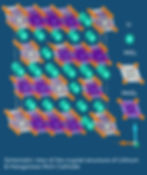The Future of EV Batteries: Unlocking the Power of Lithium and Manganese-Rich Cathode Materials (LMR)
- valery_noryk
- Jun 13, 2025
- 4 min read
As the world accelerates toward a greener and more sustainable future, the importance of advanced battery technologies cannot be overstated. From electric vehicles (EVs) to large-scale energy storage systems (ESS), batteries are the silent workhorses powering the clean energy revolution. In this rapidly evolving space, Lithium and Manganese-Rich Cathode Materials (LMR) are emerging as a highly promising solution that could reshape the future of lithium-ion batteries.
Offering an optimal balance between energy density, safety, and cost-effectiveness, LMR cathodes represent a strategic step forward — especially for manufacturers and developers seeking alternatives to expensive and ethically problematic materials like cobalt.
What Are Lithium and Manganese-Rich Cathode Materials (LMR)?
Lithium and Manganese-Rich Cathode Materials (LMR) are an innovative class of cathode materials used in lithium-ion batteries. These materials are characterized by a high proportion of manganese — typically more than 50% — along with lithium and smaller amounts of nickel. Importantly, they are designed to operate at high voltages exceeding 4.5V, with an energy density ranging from 225 to 245 mAh/g, making them competitive with more traditional high-nickel NMC chemistries.

From a structural standpoint, LMR cathodes have a unique layered crystal architecture, combining ordered lithium-transition metal oxides (like MnO₆ and NiO₆) in a way that supports high energy output and long-term stability. This molecular configuration not only allows for efficient lithium-ion transport but also helps ensure thermal stability — a critical factor for battery safety.
Advantages of LMR
As the demand for high-performing and safe batteries continues to rise, LMR cathodes offer a compelling list of advantages for both EV manufacturers and energy storage developers:
1. High Energy Density
While LMR may not quite match the very highest energy densities offered by high-nickel NCM (Nickel-Cobalt-Manganese) cathodes, it still delivers very competitive performance, making it suitable for a broad range of applications — from mid-range electric vehicles to stationary storage solutions. The high energy density translates into longer driving ranges and fewer charging cycles.
2. Excellent Safety Profile
One of the standout benefits of LMR materials is their enhanced thermal and chemical stability. Thanks to their low nickel content, these cathodes are less prone to thermal runaway and side reactions, particularly at high voltages. This makes them safer under extreme operating conditions and particularly attractive for automotive applications where safety is paramount.
3. Reduced Material Costs
LMR cathodes are designed to minimize or eliminate the use of cobalt, a metal that is both expensive and associated with significant ethical and environmental concerns. Manganese, in contrast, is more abundant, less costly, and easier to source. This cost benefit makes LMR-based batteries a more economical solution for manufacturers operating at scale.
4. Lower Environmental Impact
With the transition toward sustainable technologies, reducing the ecological footprint of battery production is becoming increasingly important. LMR’s low reliance on cobalt and nickel helps reduce the environmental impact of mining and processing, making it a more sustainable option.
5. Versatile Applications
LMR cathodes are well-suited for use in both electric vehicles and energy storage systems. Their safety and affordability make them a strong candidate for mainstream EVs, public transportation fleets, and grid-level energy storage, where cost and stability matter as much as raw performance.
Challenges & Solutions: Navigating the Road Ahead for LMR Technology
Like any emerging technology, LMR are not without their limitations. However, researchers and manufacturers are actively addressing these issues through innovation and optimization.
1. Limited Battery Cycle Life
One of the most significant challenges facing LMR cathodes is their relatively short cycle life. This is primarily due to side reactions between the cathode material and the battery’s electrolyte, especially during prolonged high-voltage operation. These reactions can degrade the cathode surface and lead to loss of capacity over time.
Solution: Researchers are exploring advanced surface coating techniques, such as applying protective oxide layers, to act as a buffer and prevent unwanted chemical interactions. In addition, cation doping — introducing stabilizing elements like aluminum or titanium—has been shown to enhance structural stability and extend battery life.
2. Voltage Fade Over Time
LMR materials are also susceptible to a phenomenon known as voltage fade, where the average discharge voltage decreases after many cycles, resulting in reduced energy efficiency.
Solution: Optimizing the particle morphology and microstructure of the cathode material has shown promise in mitigating voltage fade. Engineers are also refining the synthesis process to control the crystal structure more precisely, preserving the material's electrochemical integrity.
3. Initial Irreversible Capacity Loss
LMR cathodes can suffer from an initial loss of capacity due to the trapping of lithium ions during the first few cycles. This effect can limit the full energy potential of the battery.
Solution: Pre-lithiation techniques and electrolyte additives are being introduced to compensate for this loss and restore higher initial capacity. These methods are already showing success in lab and early commercial trials.
Why Now Is the Time to Invest in LMR Technology?
With its compelling combination of high energy density, excellent safety profile, reduced costs, and long-term sustainability, Lithium and Manganese-Rich Cathode Materials (LMR) are quickly becoming a critical focus area for battery innovation. As EV adoption grows and demand for grid-scale energy storage expands, the pressure is on to develop batteries that are not just powerful — but also safe, affordable, and sustainable.
LMR represents a technology with the potential to meet these demands, particularly for mid-market electric vehicles and cost-sensitive applications where ultra-high energy density is not the only requirement.
At ALEXEC Consulting, we specialize in cutting-edge battery materials research, strategic sourcing, and technology roadmapping. Our team has deep domain expertise in cathode chemistries — including LMR, NCM, and LFP — and we’re ready to help you leverage the best material solutions for your unique goals.

